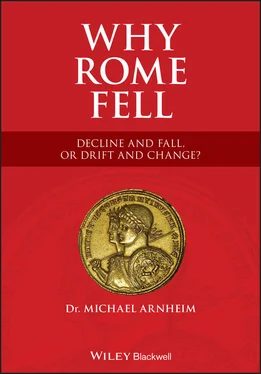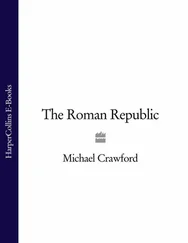Michael Arnheim - Why Rome Fell
Здесь есть возможность читать онлайн «Michael Arnheim - Why Rome Fell» — ознакомительный отрывок электронной книги совершенно бесплатно, а после прочтения отрывка купить полную версию. В некоторых случаях можно слушать аудио, скачать через торрент в формате fb2 и присутствует краткое содержание. Жанр: unrecognised, на английском языке. Описание произведения, (предисловие) а так же отзывы посетителей доступны на портале библиотеки ЛибКат.
- Название:Why Rome Fell
- Автор:
- Жанр:
- Год:неизвестен
- ISBN:нет данных
- Рейтинг книги:3 / 5. Голосов: 1
-
Избранное:Добавить в избранное
- Отзывы:
-
Ваша оценка:
- 60
- 1
- 2
- 3
- 4
- 5
Why Rome Fell: краткое содержание, описание и аннотация
Предлагаем к чтению аннотацию, описание, краткое содержание или предисловие (зависит от того, что написал сам автор книги «Why Rome Fell»). Если вы не нашли необходимую информацию о книге — напишите в комментариях, мы постараемся отыскать её.
Why Rome Fell: Decline and Fall, or Drift and Change?
Why Rome Fell
Why Rome Fell
Why Rome Fell — читать онлайн ознакомительный отрывок
Ниже представлен текст книги, разбитый по страницам. Система сохранения места последней прочитанной страницы, позволяет с удобством читать онлайн бесплатно книгу «Why Rome Fell», без необходимости каждый раз заново искать на чём Вы остановились. Поставьте закладку, и сможете в любой момент перейти на страницу, на которой закончили чтение.
Интервал:
Закладка:
Between Caracalla’s assassination in 217 and the accession of Diocletian in 284, a succession of emperors met a similar fate. The period from 235 to 284 is known as the Crisis of the Third Century when the Roman Empire’s very existence was threatened by a combination of threats, foreign, domestic, military, political, and economic.
Diocletian’s solution stabilized the Empire, at least temporarily. As a military man, his focus was primarily on defense and security. By sharing his power with three other emperors in the so-called tetrarchy (rule of four) and by greatly increasing the number of provinces, and separating military and civil commands, he secured the frontiers while tightening the administration of the Empire. The Christian writer Lactantius (c.250–c. 325) went so far as to claim that, under Diocletian, there were more men on the government’s payroll than taxpayers! (Lactantius, Mort. Pers ., 7.3). This was an exaggeration, but modern estimates still suggest that Diocletian doubled the size of the civil service from about 15,000 to 30,000. (Treadgold 1997, p. 19.) On the basis of a population of between 50 and 65 million, this averages out at about one official per 2,000 inhabitants. (Jones 1964, p. 594. Cf. Bagnall 1987, p. 66.)
The corollary to this was the compilation of the Gregorian and Hermogenian Codes under Diocletian’s direction, codification being a novelty at the time, which was to burgeon greatly in the future, right up to the present day. Diocletian took very seriously his responsibility as the fount of all law, and there are about 1,200 rescripts still surviving, probably only a fraction of those issued, chiefly from the period 293–294 alone. (See S. Connolly 2010.) Rescripts are legal responses, probably drafted by professional government lawyers in the scrinium a libellis (imperial secretariat), to petitions from people of varying degrees all around the Empire. (See Honoré 1979, pp. 51–64.)
Men of senatorial origin had a monopoly on provincial governorships under Augustus. This was one of the chief ways that this master politician was able to placate this important class, leading members of which had been responsible for that cataclysmic event on the Ides of March 44 BCE. As time went by, emperor after emperor continued to dilute the senatorial order with men of their own choosing from outside the order and, increasingly, from outside Italy. In the third century, emperors started appointing non-senators to governorships without even bothering to dunk them in the curia (senate-house) first. Diocletian completed this process, largely eliminating members of the senatorial order from positions of any importance.
Principate to Dominate
Diocletian’s accession to power in 284 is an important watershed in the conventional chronology of the Roman Empire, marking the end of the Augustan Principate and the beginning of a new form of autocratic monarchy labeled by modern historians the Dominate, or simply as the beginning of the Later Roman Empire, or in French, as the transition from Le Haut-Empire to Le Bas-Empire . Adherents of the “World of Late Antiquity” school trace Late Antiquity as far back as to the period around the year 150. Oxford University in its wisdom also used to designate 284 as marking the beginning of its “Modern History Schools” syllabus!
My own view is that, though Diocletian’s rule marks an important break with the past, it also represents the culmination of trends that can be traced back to the beginning of the Principate, including the sidelining of the senatorial aristocracy, which, however, was reversed in the West under Constantine, as is shown in Chapter 3.
Pomp and Ceremony
The pomp and ceremony associated with Diocletian’s court are among the main reasons for the image of autocracy conjured up by his name. Here, for example, is a quotation from Sextus Aurelius Victor, writing in 361, stressing the outward trappings of Diocletian’s rule that supposedly differentiated it from those of his predecessors: “He was the first to seek a robe made of gold and desired a large amount of silk, purple dye, and gems for his footwear. Although this finery was ostentatious and signs of a conceited and extravagant disposition, nevertheless these vices were insignificant compared to other things. For he was the first of all the emperors since Caligula and Domitian to allow people to openly call him Dominus ( Lord) and to worship him, and address him as a god.” (Aurelius Victor, De Caesaribus , 39.)
This is a gross exaggeration of Diocletian’s responsibility for initiating these ceremonial features, most of which can be traced back to earlier emperors. Even the designation of the emperor as dominus noster (our lord), which is what made modern historians dub the period the Dominate, in fact first appeared in the reign of Septimius Severus (193–211) and became quite general during the third century, well before Diocletian’s accession in 284.
Purple gradually became the imperial color. At the same time, the sceptre, long associated with Jupiter as chief god, became an adjunct to imperial costume from the time of the Severan emperors (combined reigns 193–235). The globe, symbol of rulership of the world, was to be seen on coins of Caracalla (r. 198–217) and Philip the Arab (r. 244–249.) To go with his elevated image, the emperor was even sometimes portrayed with a halo, or nimbus, a sign of divinity, as can be seen in representations of gods in wall-paintings from Pompeii (destroyed in the year 79) but only applied to living emperors from Constantine onward, notably on the Missorium (large ceremonial silver dish) of Theodosius I (r. 379–395.)
One innovation attributed to Diocletian by Ammianus Marcellinus, a much more reliable source than Aurelius Victor, is adoratio (doing obeisance) or supplicatio , before the emperor and kissing the hem of his purple robe. (Ammianus 15.5.18.) Some scholars have even found precedents for this among earlier emperors, notably Probus (r. 276–282), but the evidence for a Diocletianic origin is fairly strong. (See H. Stern 1954, pages 184–99 .)
An oath by the emperor’s genius (attendant spirit) was now considered more binding even than one by the gods. ( Dig . XII.2.13.6; ILS 618.) And coin legends of Aurelian boldly describe the living emperor as a god: IMPERATORI DEO ET DOMINO AVRELIANO. (Mattingly-Sydenham V.1.264, 299, nos. 305 ff.) Descriptions of Diocletian’s tetrarchy gave this formula a new twist. A marble milestone on the Via Egnatia on the way to Dyrrachium (later Durazzo, now Durres in Albania) in Illyricum is dedicated to: DIIS GENITIS ET/ DEORVM CREATORIBUS DD(OMINIS) NN(OSTRIS) DIOCLETIANO ET/ [MAXIMIANO INVIC]TIS AVGG(VSTIS) (To our Lords the invincible Diocletian and Maximian, offspring of gods and creator of gods) (CIL III.710 = ILS 629). The imperial pair are here described both as of divine descent and as the progenitors of gods, presumably the two Caesars who joined the tetrarchy in 293. From the early third century, everything connected with the emperor was described as sacrum or in Greek as hieron (sacred or holy).
However, certain other features associated with imperial claims to divinity are missing from the reign of Diocletian. One example is the radiate crown of the sun-god Apollo, first seen on coins portraying the deified Augustus and first worn on coins minted in his own lifetime by Nero (r. 54–68) (Mattingly-Sydenham, Vol. III, p. 178 f., and plate XI), followed, surprisingly enough, by coins minted in Antioch during the reign of Trajan (98–117). In the third century, this blatant symbol of the divinity of the living emperor was a regular feature on the imperial coinage, for example, under Aurelian (r. 270–275), but this fashion accessory was never adopted by Diocletian. (Rostovtzeff 1923, pp. 91–109.) A jewelled diadem, also associated with the sun-god, started appearing on coins of Gallienus (r. 253–268) but was also never affected by Diocletian though it became common later on.
Читать дальшеИнтервал:
Закладка:
Похожие книги на «Why Rome Fell»
Представляем Вашему вниманию похожие книги на «Why Rome Fell» списком для выбора. Мы отобрали схожую по названию и смыслу литературу в надежде предоставить читателям больше вариантов отыскать новые, интересные, ещё непрочитанные произведения.
Обсуждение, отзывы о книге «Why Rome Fell» и просто собственные мнения читателей. Оставьте ваши комментарии, напишите, что Вы думаете о произведении, его смысле или главных героях. Укажите что конкретно понравилось, а что нет, и почему Вы так считаете.












